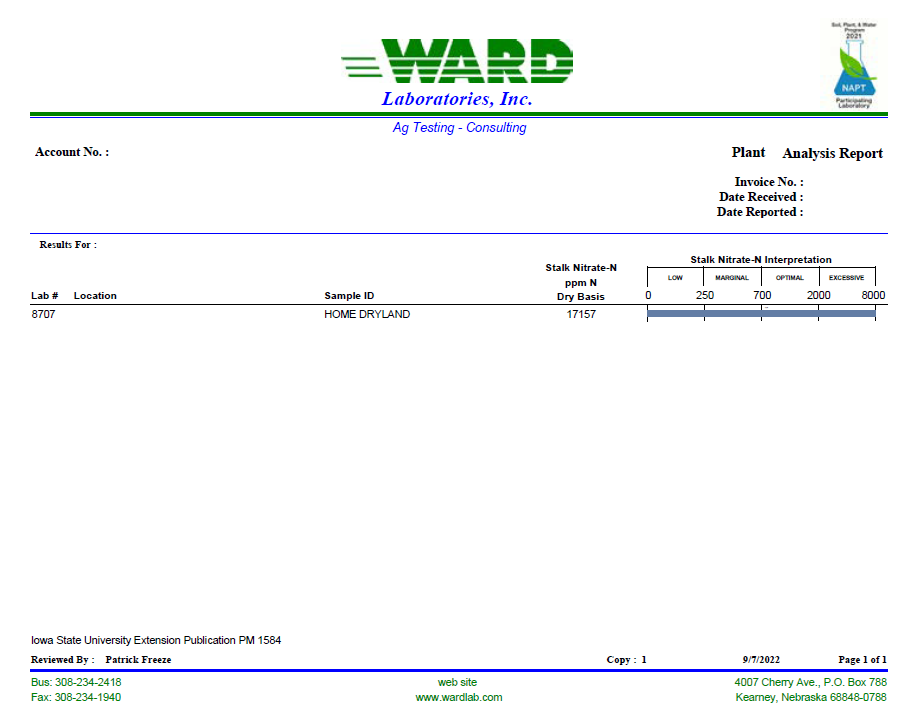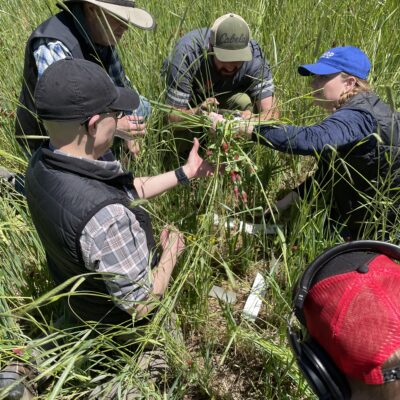Ward Laboratories has been performing stalk nitrate testing since 1990. This test can be utilized to evaluate the efficiency of your in-season nitrogen program for corn and sorghum. A stalk nitrate analysis is to be used only for agronomic management. When evaluating nitrogen use efficiency, we specifically check a lower portion of the stalk for nitrate. Hence the name of the analysis stalk nitrate. The nitrate level is related to how well the crop used the nitrogen available from the soil. University research has proven that N concentrated in the lower stalk strongly correlates with nitrogen available to corn or sorghum during the growing season.
How to Take a Stalk Nitrate Sample
- Samples should be taken approximately three weeks after black layer formation.
- Collect 10-12 stalks collected randomly across the field.
- Cut the portion of stalk from 6-14 inches above the ground and remove any leaves.
- Bundle together with duct tape and write sample information on the tape. Include: Farm name, field name and a sample ID of your choosing.
- Submit samples to Ward Laboratories Inc.
Understanding Your Report
Upon completion of analysis, you will receive a report. This report will show what range your nitrates are in.

At season’s end, we like to see stalk nitrate ppm in the optimum range. Corn or sorghum with optimal or inadequate N remove nitrogen from the lower leaves and stalk during grain fill, therefore rendering lower N levels in the lower stalk. On the flipside, over fertilization of N will cause the lower leaves to remain green resulting in heavy concentration of N in the lower stalk. Nitrate testing is useful in evaluating any on-farm trials with nitrogen such as application rates and/or timing of application.
The optimum concentration of nitrate in the lower stalk is 700ppm to 2000 ppm. Marginal range is 250 ppm to 700 ppm. A test result below 250 ppm would fall in the low range. Heavy pre-plant or at planting application of N could potentially cause low stalk nitrate levels. In the same vein, too much unneeded N applied late would likely move stalk nitrate ppm into the excessive category, which would be above 2000 ppm. Another valuable use for the test is on manured fields where the N supply in the manure is unknown. First year corn fields following alfalfa can benefit.
If it is low, we potentially underapplied nitrogen. If it is in the excessive range, perhaps we overapplied. In conjunction, we also like to see very low levels of nitrate in the soil at season’s end. This prevents NO3 leaching below the root zone or into the water in the case of a heavy moisture event. This is especially true on course textured soils. Nitrogen is a major crop input expense. Preserving N for future use can have a positive impact on a farm’s financial bottom line.
Another Tool for Farming Fertility
Farmers in recent years have multiple tools at their disposal to fine-tune their fertility programs. Grid soil sampling and multi-event tissue testing in-season are two of the most used tools to help improve fertility. New tools such as crop canopy nitrate sensing can also be utilized. Stalk nitrate testing can be a good addition to a producer’s fertility management programs.
To conclude, stalk nitrate analysis is a valuable tool for producers looking to hone in on nitrogen use efficiency. Paired with an end of season soil analysis, producers can make fertility adjustments before the next season. This will help insure that soil nitrate is properly managed.





can you also test well water ? wiede.john2gmail.com
Yes! We do all kinds of water analysis! https://www.wardlab.com/services/water-analysis/